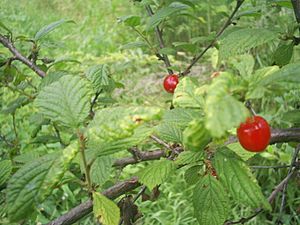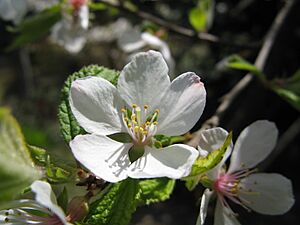Prunus tomentosa facts for kids
Prunus tomentosa is a type of small bush or shrub that is also known by many other names, like Nanjing cherry, Korean cherry, and Chinese bush cherry. Even though it's often called a "cherry," it's actually more closely related to plums! This plant is originally from places like China, Korea, and Mongolia. People have grown it for a very long time in eastern Asia because of its pretty flowers and tasty fruit.
Quick facts for kids Prunus tomentosa |
|
|---|---|
 |
|
| Leaves and fruit (drupes) | |
| Scientific classification | |
| Genus: |
Prunus
|
| Species: |
tomentosa
|
What Does it Look Like?
The Nanking cherry is a deciduous shrub, which means it's a bush that loses its leaves in the fall. It can grow to be about 0.3 to 3 meters (about 1 to 10 feet) tall. Its bark is smooth and has a cool copper-black color.
The leaves are usually 2–7 cm long and 1–3.5 cm wide. They are dark green and have a slightly bumpy, hairy feel, especially on the underside.
In spring, before or as the leaves appear, the plant bursts with many white or pink flowers. These flowers are about 1.5–2.0 cm wide and grow in pretty clusters.
The fruit is a small, round, scarlet-red fruit called a drupe. It's usually 5–12 mm wide, but sometimes can be larger. It ripens in early summer and has a sweet but slightly tart taste with a single large seed inside.
This plant loves sunny spots and can grow in many different kinds of soil. It's also good at handling dry weather and very cold temperatures.
What is it Used For?
People grow the Nanking cherry for many reasons. Its fruit is edible and can be used to make juice, jam, and even wine! It's also used in pickled vegetables.
Besides its fruit, the plant is very popular as an ornamental plant because of its beautiful flowers and fruit. Gardeners sometimes prune it to create interesting shapes, like for bonsai trees.
It can also be used as a special base plant (called a dwarfing rootstock) for other cherry trees, helping them stay smaller. In some cold, windy places, like the Midwest United States, these bushes are planted in long rows to create a windbreak, protecting other plants and homes.
There are different types of Nanking cherry plants, called cultivars, that have been developed. Some examples include 'Leucocarpa', which produces white fruit!
Things to Watch Out For
Like many plants, the Nanking cherry can sometimes have problems. It might get tiny borer insects, which can damage the plant. If the plant is stressed, it can also get a disease called brown rot.
This plant doesn't do very well in places that are very hot and humid, like the southern United States. It prefers cooler, drier climates.






